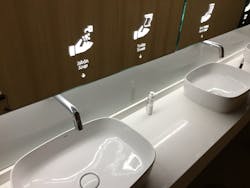Consumer technology is rapidly becoming more responsive to users’ needs. Anything from a rideshare to a week’s worth of groceries can be summoned with a few taps in an app. People are starting to expect this convenience in every corner of their lives, and buildings must keep up to keep employees, guests and clients happy.
Products like Comfy have already started making inroads into personalized building services. The app connects to your existing workplace systems to give workers some control over temperature, lighting, meeting rooms and hot desk availability. It also works as a GPS of sorts to locate building amenities and lets people submit work requests right to the facilities department, increasing their satisfaction by ensuring they feel heard.
[Trending: Individual HVAC Control]
Fortunately, you don’t have to completely renovate your space to implement many of the consumer-centered technologies on the market. These innovative offerings are an easy way to make a space more responsive without a complete redesign.
Flexible Furnishings
Swapping out furniture is one of the easiest updates. Height-adjustable or sit-stand desks (including products like JUV that build into the wall) are refreshing for occupants and easy to install. Just make sure they’re ergonomically sound, so you’re not trading one problem for another.
Simple strategies like Senator’s Pailo create opportunities for customization even among transient bench-desking systems.
Check out this demo from one of our selected products from Product Innovations 2018:
Good workplace furnishings also encourage occupants to feel invested in the space. Choose seating, desks and tables that can be repositioned by just one or two people. This will allow people to adapt spaces according to their needs, becoming active participants in a dynamic space rather than passive users of a static space.
Collections like Koleksiyon’s Plan put the furniture layout in occupants’ hands. So do desks like Wilkhahn’s Confair Mobile Desk, which is easy to move and even stacks together when it’s not in use.
Another way to encourage investment is to specify furnishings that make active participation effortless. For example, a table like Koleksiyon’s Tabula is intended for collaboration spaces, but it’s not just part of a collaboration space — it’s part of the collaboration itself. The tiltable table has a writable surface inspired by an artist’s easel. The ease of movement lets users easily change the dynamic on the fly.
Help BUILDINGS Shape 2019!
What BUILDINGS resources are most valuable to you? What would you like to see us provide?
Please take our short (under 2 minutes) survey - just 5 short questions.
Thank you!
Purposeful Partitions
When it comes to designing commercial spaces, walls and partitions should enable creativity, not box it in. Try painting a section of your existing walls with dry erase or magnetic paint to extend the boundaries of occupants’ creativity.
Dealing with an open floor plan? Many manufacturers offer solutions that let you create your own offices and workstations without hampering collaboration and creativity.
Modular partition systems like SUNLINE and QuickFlex Walls have different styles and surfaces that can be swapped out to create different types of spaces. Freestanding systems like Herman Miller’s Overlay are easy to relocate if your space needs change.
Watch this moveable partition demo:
Desktop privacy screens, such as this one from FilzFelt, offer another alternative for maintaining individual privacy in group-oriented spaces.
Advanced Acoustics
Spaces that are meant for the most sensitive conversations will require additional attention to acoustics. Sound masking systems – adding generated sound that reduces distractions and protects privacy – can help with this. However, acoustic concerns are often overlooked during construction, and retrofitting an entire office space with sound masking may be financially unfeasible.
[Check out: Acoustics and the Impact of Sound on Health]
QT Conference Room Edition, a sound masking package by Cambridge Sound Management, features a control module that installs in a conference or board room. The participants can activate the sound masking emitters when they’re about to have a sensitive or confidential conversation. When the system is active, privacy signs automatically light up inside and outside the room.
Luxe Lighting Options
Occupants have widely varying lighting preferences depending on all sorts of factors. The intended use of each space also plays a role – some tasks simply require more light. But once the lighting layout is in place, it can be difficult to change it, even if you’re reconfiguring the space and the existing lighting is no longer adequate.
Safeguard against this by specifying customizable lighting that can be updated later. Systems like THIN Suspension by Juniper can be rotated, connected and moved around as the space’s needs or capacity change. THIN Suspension’s dimmable LED light segments interlock with magnets for easy disassembly and reassembly.
For hotel rooms, consider myRoom, a light, temperature and shade control system made specifically for hospitality. It picks up on guests’ presence by sensing occupancy, door open/close and keypad button press information. Lights, window coverings and HVAC settings are in the guest’s hands. A dashboard lets the facilities staff monitor and troubleshoot guestroom systems from a computer or tablet.
Users can interface with the sensor to control with their voice. “Dim the lights, close the blinds, lock the doors, turn on the projectors,” whatever you want.
This product is ideal for conference rooms, classrooms, hospitality, hotel rooms, etc. It’s placed on the ceiling but has a mic and speaker so you can talk to it or connect via Bluetooth.
Relaxing Restrooms
No one likes to think about the restroom, but it’s a key part of how your facility is perceived no matter what business you’re in. People don’t want to encounter a restroom that’s dirty, uncomfortable or simply out of supplies.
A survey conducted by washroom fixture manufacturer Bradley Corp. found that 60 percent of adults over 55 are unlikely to return to a business with an unpleasant restroom. User-friendly additions that improve the restroom experience could be the key to keeping your guests happy.
Sophisticated toilets like the Kohler Numi elevate restrooms from generic to luxurious. The Numi is a type of intelligent toilet with a motion sensor that opens and closes the seat and lid hands-free. It also features a heated seat, a foot warmer, an integrated self-cleaning wand and an air dryer. A charcoal filter eliminates odors, while built-in speakers can stream music, podcasts and radio stations.
For restrooms with multiple stalls, think about a motion-activated air freshener like GP Pro’s Active Aire. Users wave their hands in front of the silver surface to release a discreet puff of scent. Amenities like these are perfect for high-traffic restrooms (such as the Hartsfield-Jackson Atlanta International Airport, where we spotted it).
[Related: A Bathroom Automation Narrative]
Hospitality applications and other places where a comforting shower is crucial might opt for a shower-based entertainment system like ThermaTouch by ThermaSol. Its in-shower LCD controller lets the user personalize a spa-like restroom environment.
Guests can use the waterproof touchscreen to set the temperature and length of a steam session, control mobile apps like Pandora or Netflix, or access the nine nature-themed sound and visualization combos of its Tranquility Mode.
Improvements like these can be the deciding factor that sets your facility apart from the competition. How will you put control in your occupants’ hands?
Two handpicked articles to read next:
About the Author
Janelle Penny
Editor-in-Chief at BUILDINGS
Janelle Penny has been with BUILDINGS since 2010. She is a two-time FOLIO: Eddie award winner who aims to deliver practical, actionable content for building owners and facilities professionals.



